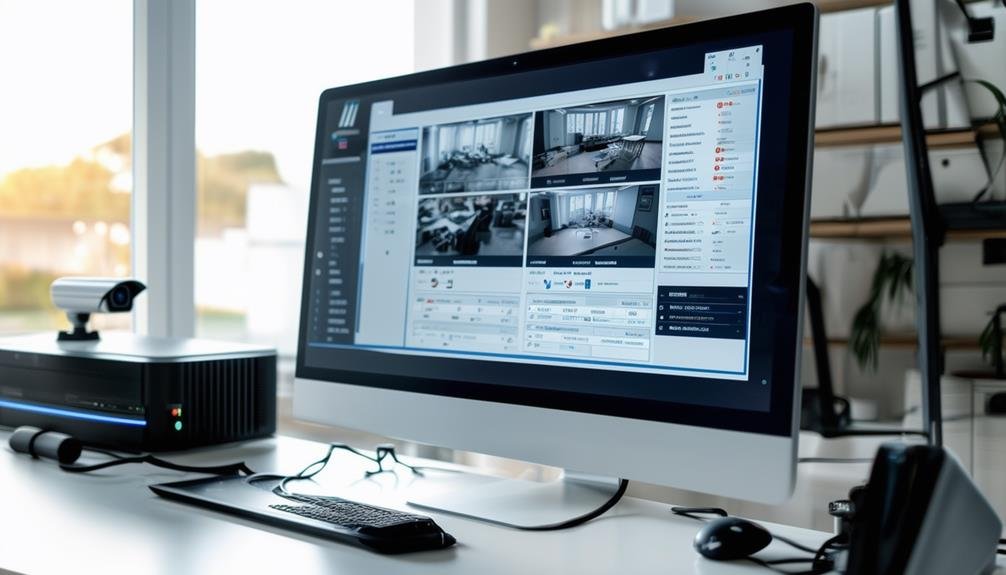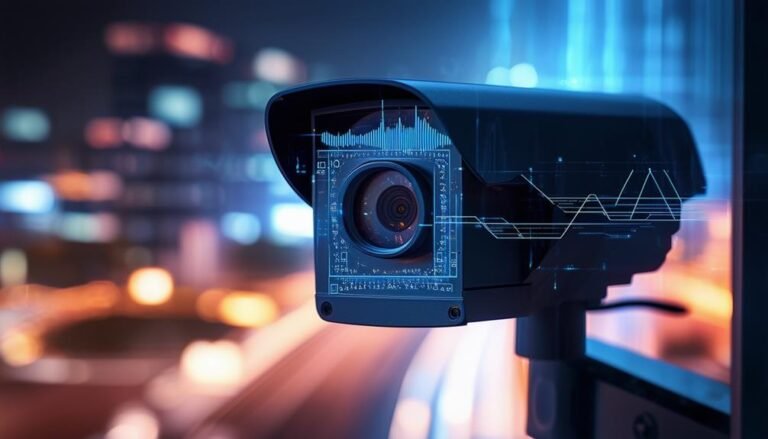To view your Dahua NVR on a PC, start by ensuring your system meets the requirements. Download the Dahua software from the official site, then install it by following the prompts. Once installed, make sure your NVR is powered on and connected to the same network as your PC. Open the software and add your NVR by entering its IP address, username, and password. You can then access live footage and recorded videos directly through the interface. There's more to optimize your setup and troubleshoot, so you might want to explore additional tips for a smoother experience.
System Requirements
To successfully view your Dahua NVR on a PC, you'll need to confirm your system meets certain requirements. First off, make sure your operating system is compatible. Dahua's software typically works with Windows 7, 8, 10, and sometimes even Mac OS, but you'll want to check the latest updates for specifics. Having the right OS gives you the freedom to explore your NVR's capabilities without any hiccups.
Next, consider your hardware. A decent processor is important—at least an Intel i3 or equivalent will do, but if you want smoother performance, aim for an i5 or higher. You'll also need 4GB of RAM, though 8GB is ideal, especially if you plan to multitask. Your graphics card should support at least DirectX 9.0; otherwise, you might find yourself missing out on some features.
Don't forget about storage! Confirm you have enough disk space for the software and any recordings you want to access. A solid-state drive (SSD) is preferred for speed, but a traditional hard drive works too, as long as it has enough capacity.
Lastly, a stable internet connection is essential. A minimum speed of 2 Mbps is recommended for streaming, but faster is always better to confirm you can access your footage without interruptions. By meeting these requirements, you'll set yourself up for a seamless experience viewing your Dahua NVR on your PC. Enjoy the freedom of monitoring your space with ease!
Downloading the Software
Now that you know the system requirements, it's important to download the software you'll need. You'll find the application on Dahua's official website, and it's crucial to follow the instructions carefully. Let's walk through the installation process step by step to make sure everything runs smoothly.
System Requirements Overview
What do you need to guarantee a smooth experience when downloading the software for your Dahua NVR on a PC? First things first, make sure your system meets the necessary requirements. Here's a quick rundown of what you'll need to keep things running smoothly:
- Operating System: Windows 7, 8, 10, or later (64-bit recommended)
- Processor: Intel Core i3 or equivalent (or better)
- RAM: At least 4 GB (8 GB preferred for peak performance)
- Graphics Card: DirectX 9.0c compatible
- Internet Connection: Stable and fast connection for downloading and updates
With these specs checked off, you'll be ready to tackle the download and installation process without a hitch. Ensuring your PC is up to par not only makes the download quicker but also enhances your overall experience when accessing live feeds and recorded footage. So, before you jump in, take a moment to verify that your system aligns with these requirements. This way, you can enjoy the freedom of accessing your Dahua NVR without any frustrating interruptions.
Downloading the Application
Getting started with your Dahua NVR involves downloading the necessary application for your PC. This software will enable you to access and manage your surveillance system seamlessly. To make this process straightforward, here's a quick guide on what you'll need to take into account while downloading.
| Step | Action Required | Notes |
|---|---|---|
| 1 | Visit the Dahua website | Confirm you're on the official site. |
| 2 | Navigate to the 'Downloads' section | Look for the software that fits your NVR model. |
| 3 | Choose the correct application | Select Windows or Mac version based on your PC. |
| 4 | Click the download link | Save the file to an easily accessible location. |
| 5 | Check for antivirus warnings | Confirm your security settings allow the download. |
Once you've got the application downloaded, you'll be well on your way to enjoying full control of your NVR system. Remember, freedom is about having the right tools at your fingertips, and this application is an essential step in regaining that control over your security setup.
Installation Process Steps
Once you've successfully downloaded the Dahua application, the installation process is your next step. This part's pretty straightforward, and you'll be up and running in no time. Follow these simple steps to get everything set up smoothly:
- Locate the downloaded file: Check your downloads folder for the installation file.
- Double-click the installer: This'll start the installation wizard.
- Follow the prompts: Just click "Next" until you reach the "Install" button.
- Choose installation location: If you want it somewhere specific, select your preferred folder, or stick with the default.
- Complete the installation: Once it's finished, you'll see a confirmation message.
After these steps, you're ready to launch the application. Keep in mind that you might need administrative privileges, so don't hesitate to grant them when prompted. With the installation complete, you're one step closer to accessing your Dahua NVR on your PC. Embrace the freedom of monitoring your security system right from your desktop, and enjoy the peace of mind that comes with it!
Installing the Application
To view your Dahua NVR on a PC, you'll need to install the appropriate application first. This software is vital for accessing and managing your NVR remotely, giving you the freedom to monitor your security system from the comfort of your desk. Start by visiting the official Dahua Technology website. Look for the support or downloads section where you can find the software tailored for your NVR model. It's essential to select the right version to guarantee compatibility.
Once you've downloaded the application, locate the installation file, usually found in your downloads folder. Double-click the file to initiate the installation process. You'll likely be prompted to accept the license agreement—make sure to read through it, but once you're okay with the terms, go ahead and accept. Follow the on-screen instructions to proceed; this typically involves selecting a destination folder and confirming the installation settings.
During installation, be patient as the process may take a few moments. After it's complete, you should see an application icon on your desktop. If you want to keep things organized, feel free to create a dedicated folder for all your security software.
Now, you're ready to launch the application. Just double-click the icon, and you can start enjoying the convenience of accessing your Dahua NVR on your PC. With the application installed, you'll soon have the flexibility to monitor your security needs anytime, anywhere, empowering you to maintain control over your home or business.
Configuring Network Settings
Now that you've installed the application, it's time to configure your network settings. You'll need to access the network configuration menu, set your IP address, and adjust the port settings to guarantee everything connects smoothly. Let's walk through these steps to get your Dahua NVR up and running on your PC.
Accessing Network Configuration Menu
When you're ready to configure your Dahua NVR's network settings, the first step is accessing the Network Configuration Menu. This menu is essential for guaranteeing your NVR connects seamlessly to your network. Here's how you can get there quickly and efficiently:
- Connect your NVR: Verify it's powered on and connected to the network.
- Open the browser: Launch a web browser on your PC.
- Enter the IP address: Type the NVR's IP address in the address bar and hit Enter.
- Log in: Input your username and password to access the system.
- Find the Network menu: Navigate through the interface to locate the Network Configuration Menu.
Once you're in, you'll see various options to tweak your settings as needed. Remember, the freedom to customize your NVR's network settings allows you to optimize performance and security to fit your specific requirements. Take your time exploring the menu, and don't hesitate to make changes that reflect your preferences. Your NVR should serve you, and this step is vital in making it work for you!
Setting IP Address
Setting the IP address for your Dahua NVR is essential for guaranteeing it communicates effectively within your network. To get started, you'll need to access the network settings menu, which you've already done. Look for the IP configuration options; this is where you'll assign your NVR a unique IP address that fits your network.
First, check your current network setup. If you're using DHCP, your NVR can automatically obtain an IP address from your router. However, for better control, you might want to set a static IP address. Choose an address that's outside the DHCP range of your router to avoid conflicts. For instance, if your router assigns addresses from 192.168.1.2 to 192.168.1.100, you could set your NVR to 192.168.1.101.
Once you've chosen the IP address, enter it into the respective fields in the NVR's settings. Don't forget to set the subnet mask (usually 255.255.255.0) and the default gateway, typically your router's IP address. After saving these changes, reboot your NVR to guarantee it connects properly. You're now free to access your NVR seamlessly!
Configuring Port Settings
How do you guarantee your Dahua NVR can be accessed remotely? Configuring your port settings is key to guaranteeing seamless access. You'll want to set up the correct ports, allowing you to connect from anywhere without unnecessary barriers. Here's how to do it:
- Log into your Dahua NVR's web interface.
- Navigate to the "Network" settings.
- Find the "Port" configuration options.
- Guarantee the HTTP port (default is usually 80) and the RTSP port (default is often 554) are correctly set.
- Save your changes.
Next, you might need to configure your router to forward these ports. This step bridges the connection between your NVR and the outside world. Here's what to do:
- Access your router's settings.
- Locate the "Port Forwarding" section.
- Add a new rule for the HTTP and RTSP ports.
- Assign the internal IP address of your NVR.
- Save and apply the settings.
Once you've completed these steps, you're one step closer to enjoying the freedom of remote access to your Dahua NVR. Happy monitoring!
Adding the NVR Device
To add your Dahua NVR device to your PC, start by ensuring both your computer and the NVR are connected to the same network. This is essential for seamless communication between the two devices. Once you've confirmed the connection, you can proceed to add the NVR to your PC software, usually the Dahua Smart PSS or another compatible application.
Open the software and navigate to the device management section. Here, you'll want to select "Add Device." Enter the necessary details, such as the NVR's IP address, username, and password. Make sure these credentials are correct to avoid connection issues. After entering the details, hit "Add" or "OK" to register your NVR.
To help you understand the different connection methods and their advantages, here's a quick reference table:
| Connection Method | Advantages |
|---|---|
| Wired | Stable and reliable |
| Wireless | Flexibility in placement |
| P2P | Easier setup, remote access |
| VPN | Enhanced security |
Once you've added the NVR, it should appear in your device list. This step opens the gateway to accessing your cameras and viewing your recordings. Now that your device is successfully added, you're one step closer to managing your security system from the freedom of your PC. Enjoy the control and peace of mind that comes with having your surveillance system at your fingertips!
Viewing Live Footage
Viewing live footage from your Dahua NVR is a straightforward process that grants you real-time access to your surveillance cameras. This ability is essential for staying informed about what's happening in your space, whether it's for security reasons or simply keeping an eye on things. Here's how you can quickly view live footage and enjoy the freedom of remote monitoring.
- Open the Dahua software or web interface on your PC.
- Log in with your credentials. Make sure you have the right username and password.
- Navigate to the live view section. This is usually found in the main menu.
- Select the camera you want to monitor from the list displayed.
- Adjust the view settings according to your preferences—zoom in, switch angles, or even set up a multi-camera view.
Once you've completed these steps, you'll see the live feed from your selected camera. This flexibility allows you to monitor activity as it unfolds, ensuring you're always in the loop.
With your Dahua NVR, you've got the power to oversee your environment without being physically present. Enjoy the peace of mind that comes with knowing you can check in whenever you need to. Whether it's for your home or business, accessing live footage makes it easier to maintain your sense of freedom and control.
Accessing Recorded Videos
Accessing recorded videos from your Dahua NVR offers a sense of reassurance, allowing you to review past events and maintain an extensive understanding of your surveillance history. To get started, you'll need to launch the Dahua software on your PC or access the NVR through a web browser. If you're using the software, verify it's updated for peak performance.
Once you're in, head to the playback tab. Here, you'll find options to select the specific camera you wish to review. You can choose a date and time range for your search, making it easier to find the exact footage you need. If you're looking for something specific, use the search filters to narrow down your results. This can save you time and help you focus on the most relevant clips.
Don't forget to take advantage of the timeline feature. It visually represents recorded events, allowing you to jump to moments of interest quickly. If you come across a video that requires further scrutiny, consider exporting it. This enables you to save the footage to your PC or a USB drive, where you can analyze it in detail or share it with others if necessary.
Frequently Asked Questions
Can I Access My Dahua NVR Remotely?
Imagine standing in your living room, glancing at your smartphone, and seeing your home security footage live, no matter where you are. Yes, you can access your Dahua NVR remotely! With the right setup, like a stable internet connection and the appropriate software, you can monitor your property from anywhere. It's all about embracing that freedom and peace of mind, knowing you're always connected to what matters most.
What Should I Do if the Software Won't Install?
If the software won't install, don't panic! First, check your system requirements to guarantee compatibility. You might need to disable antivirus or firewall temporarily, as they can block installations. Make sure you're running the installer as an administrator; right-click and select "Run as administrator." If it still won't work, try downloading the latest version from the manufacturer's website. Sometimes, a simple restart can clear up any lingering issues too.
How Do I Reset My Dahua NVR Password?
If you need to reset your Dahua NVR password, you can usually start by accessing the device's menu. Look for the "Forgot Password" option, which may guide you through a reset process. If that doesn't work, you might need to contact Dahua's support for assistance. They can provide necessary steps or firmware updates to help you regain access. Just remember, keeping your password secure is important for your system's safety.
Is There a Mobile App for Viewing NVR Footage?
You might think there's no way to check your NVR footage on the go, but that's not true! There's a mobile app available that lets you access your Dahua NVR remotely. It's designed for freedom, giving you the ability to monitor your security footage anytime, anywhere. Just download the app, log in with your credentials, and you'll have complete control right from your smartphone. Embrace the convenience and stay connected!
What Do I Do if the Video Is Lagging?
If you're experiencing lagging video, first check your internet connection; a weak signal can cause delays. You should also try closing any unnecessary applications that might be using bandwidth. Adjusting the video quality settings can help too. If the issue persists, consider restarting the NVR or your device. Finally, verify your software is up to date, as updates often fix performance issues and enhance your viewing experience.



